India Indian music music vocalists: Quawwali Urdu
by Warren
4 comments
Meta
SiteMeter
Brighter Planet
78 rpm Records of Indian Music: Wahidanbai of Agra
In Quawwali performances, a song in praise of the Prophet Mohammed is known as a naat. Wahidanbai of Agra was also heard in Hindi film around this time; unless I’ve got the wrong artist, she was sometimes known as Wahidan Wasti.
Regardless, I enjoy these two naats for her fervent delivery and clear voice production. You will, too.
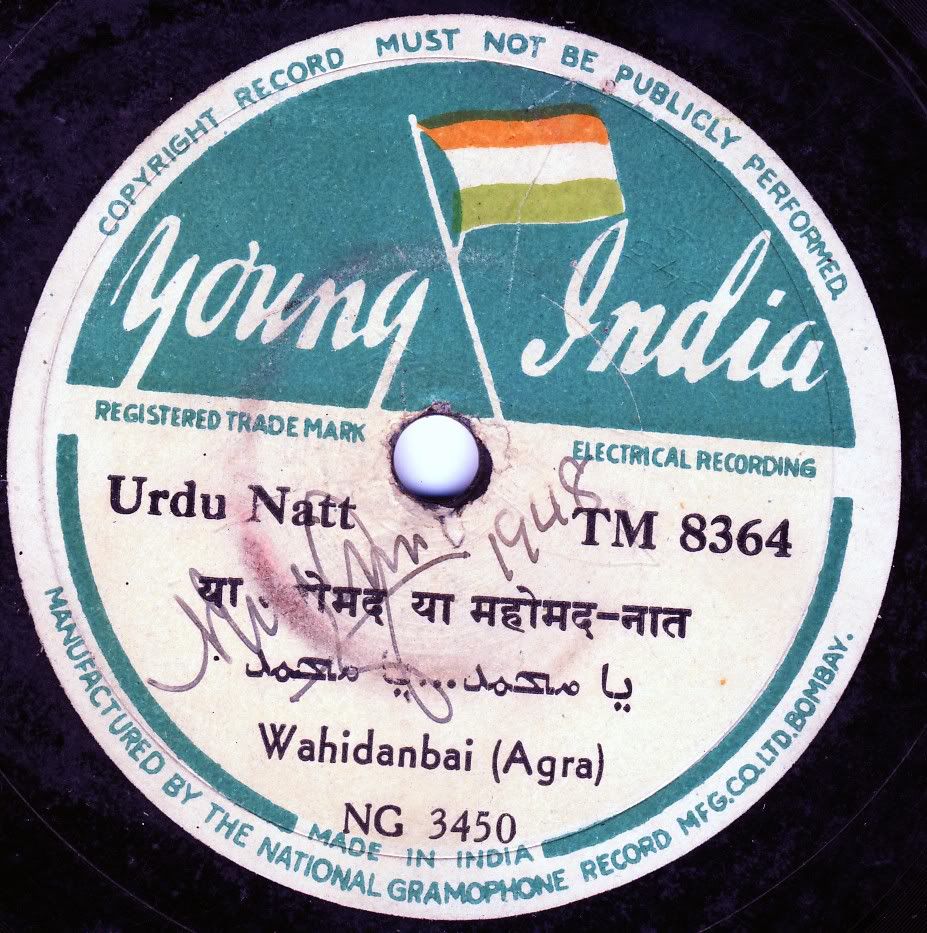
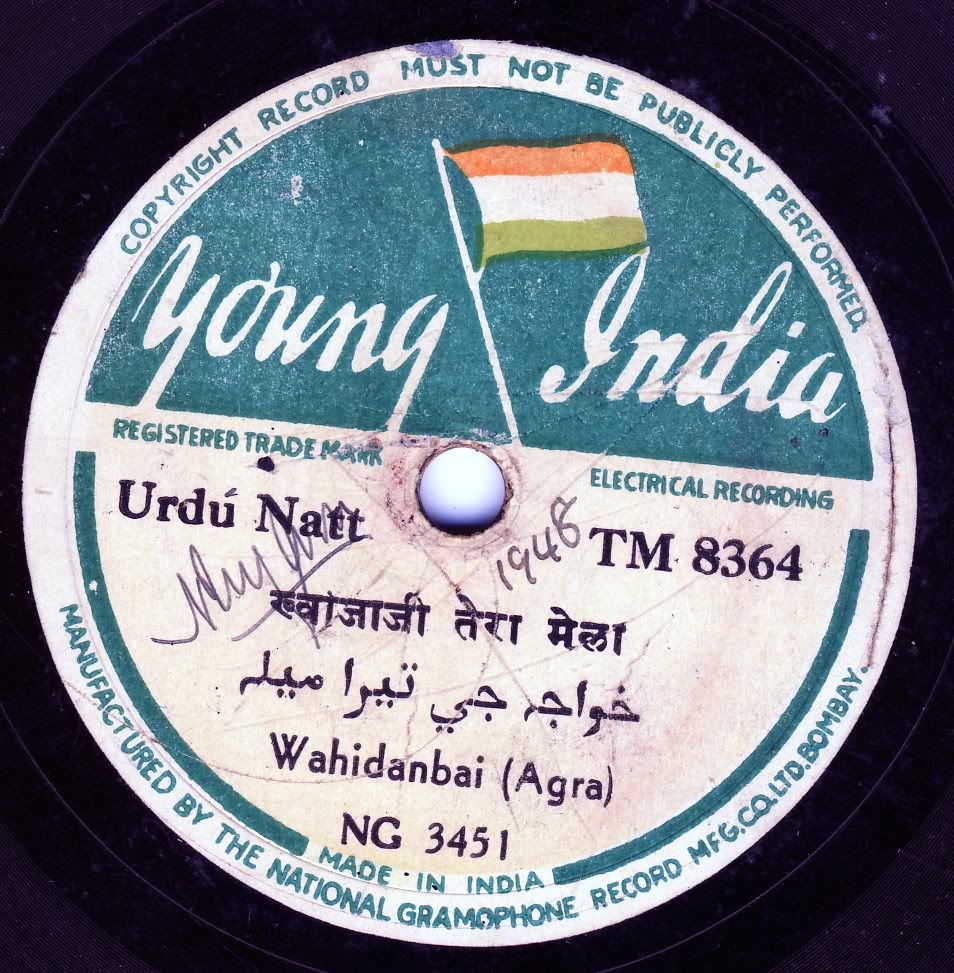
Ya Mohammed Ya Mohammed:
Khwaajaji tera mela:
The “Young India” record label was an attempt at indigenous music production:
During 1930-35, the British and German record manufacturing companies were well established and had a major share of disc manufacturing in India. The ‘Young India’ record label was an ‘indigenous’ effort at record production. The company issued over 10,000 songs on different subjects such as film music, classical music, folk music, publicity and educational material. Mainly amateur and upcoming artists have recorded on this label. The company ceased to function in 1955 so these recordings have never been reissued on audio tapes and CDs. Hence, it is important and relevant to preserve these invaluable recordings and the associated documents.
During 1935-55, the company produced over 10,000 titles on 78-rpm, 10 inch diameter shellac discs with two songs per disc. Each side could be played for over 3/3.5 minutes on spring wound gramophone machines. The recordings of film, popular, classical and folk music were issued. The repertoire covered music from different regions of India and sung in many different languages. During the long tenure of over twenty years, Indian citizens witnessed several important events such as the movement and struggle for freedom, Indian Independence in 1947, World War II and the beginning of the romantic period of independent India. This was also reflected in the records produced. Thus, there are speeches of great leaders, ballads, skits and dialogues on a number of subjects depicting changing social and political situations.

“Young India” records released many recordings of hortatory patriotic speeches. I wish I had a few of them in my collection, but these items are extremely rare.
India Indian music music vocalists: 78 rpm discs Indian folk music kutchi
by Warren
4 comments
Meta
SiteMeter
Brighter Planet
78 rpm Records of Indian Music: Kutchi Songs by Cassum Ranji
Many songs in Indian regional languages were recorded and released on 78 during the first half of the 20th century. Here’s a disc on the Zonophone label of a singer named Cassum Ranji, performing two songs in the Kutchi language. This means that even if I could figure out a single word from the recording, I wouldn’t have a clue. Appropriately enough, the labels, especially that of the B side, are almost unreadable.
“Dartro”:
Comic Song:
India Indian music music vocalists: 78 rpm discs bhajan falsetto genius
by Warren
3 comments
Meta
SiteMeter
Brighter Planet
78 rpm Records of Indian Music: Pyare Saheb — India’s Countertenor
Pyare Saheb was one of the most esteemed voices of turn-of-the-century Hindustani tradition. Singing always in a high falsetto, he recorded literally hundreds of 78 rpm discs and enjoyed high esteem amongst rasikas, especially for his sensitive handling of thumris. His music, alas, is now almost completely forgotten. Here are two samples of his singing — a popular devotional song (with some fabulous extemporized ornamental passages) and a beautiful rendition of the rarely heard raga Sorath.

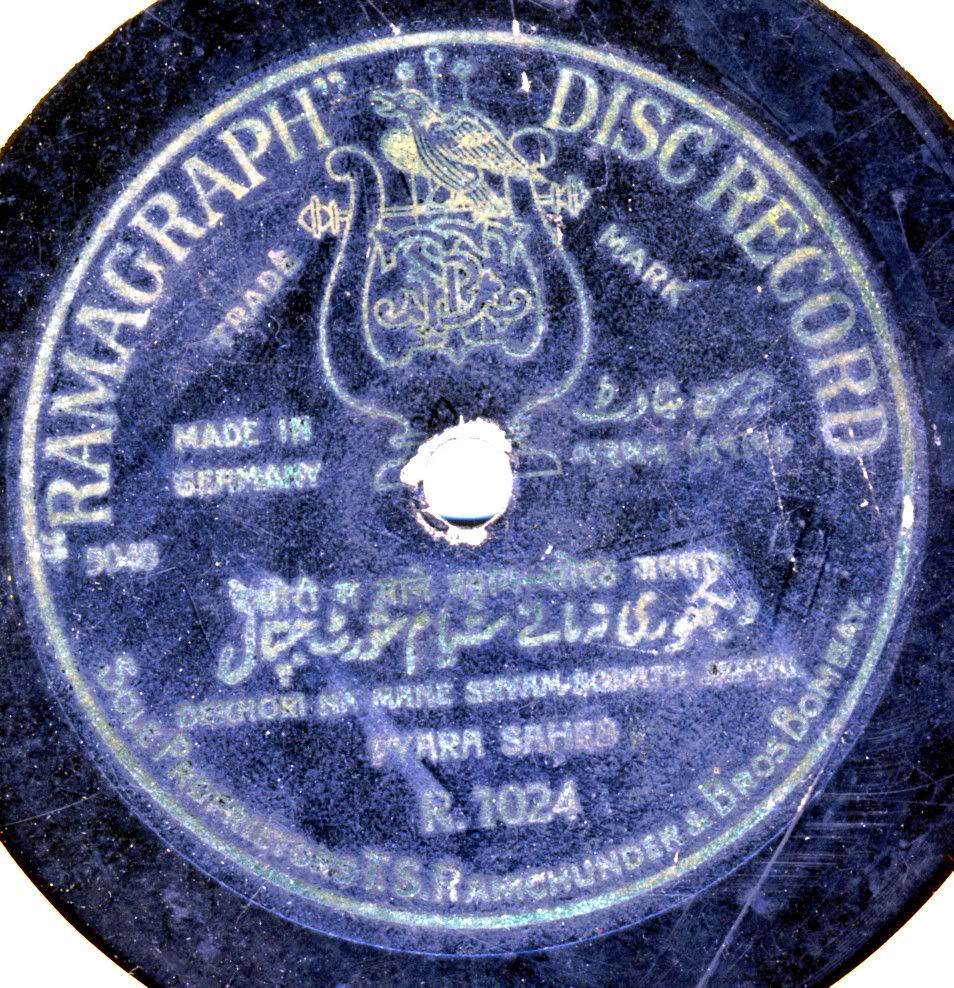
Bhajan: He Govind He Gopal
Raga Sorath: Dekhori na mane Shyam
India Indian music music vocalists: islam naat Quawwali
by Warren
3 comments
Meta
SiteMeter
Brighter Planet
78 rpm Records of Indian Music: Abdul Raheman Kanchwala & Sufi Quawal (of Patiala)
Some terrific quawwali singing from Abdul Raheman Kanchwala (who appears to have continued a performance career into the relative present, judging from the results of a little googling) and the anonymous Sufi Quawal (of Patiala). Both of these recordings were part of the collection purchased in Udaipur in 2000.
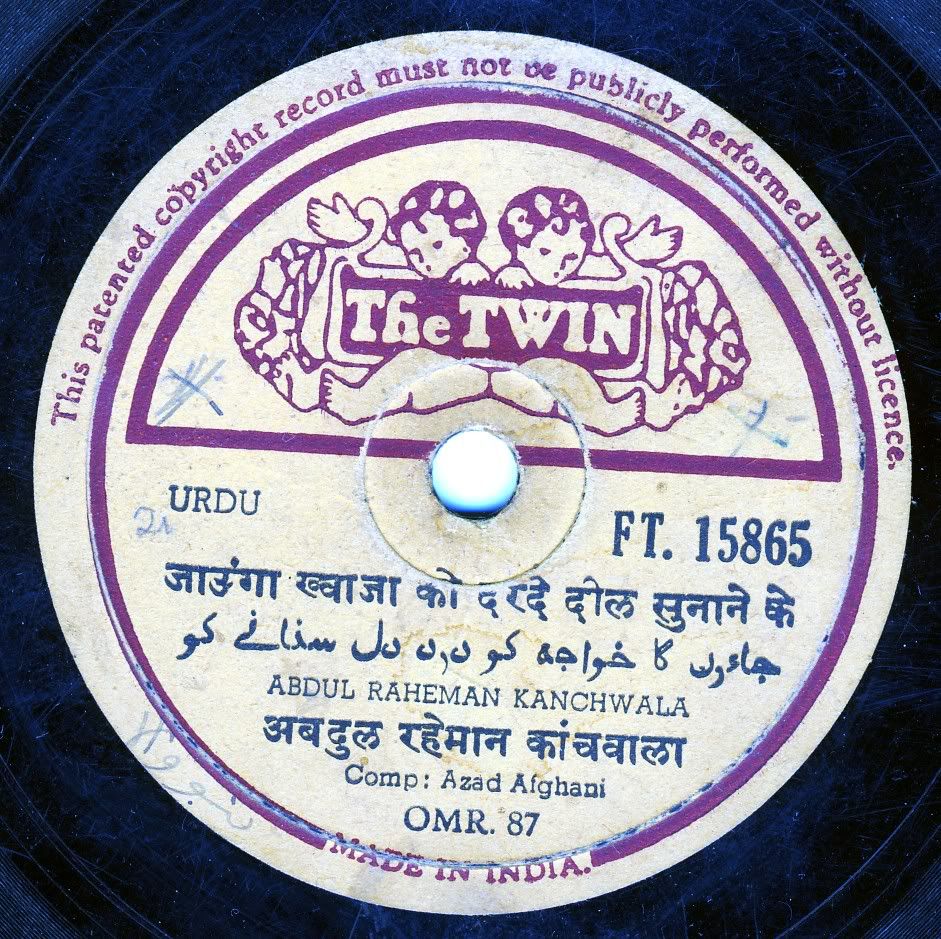
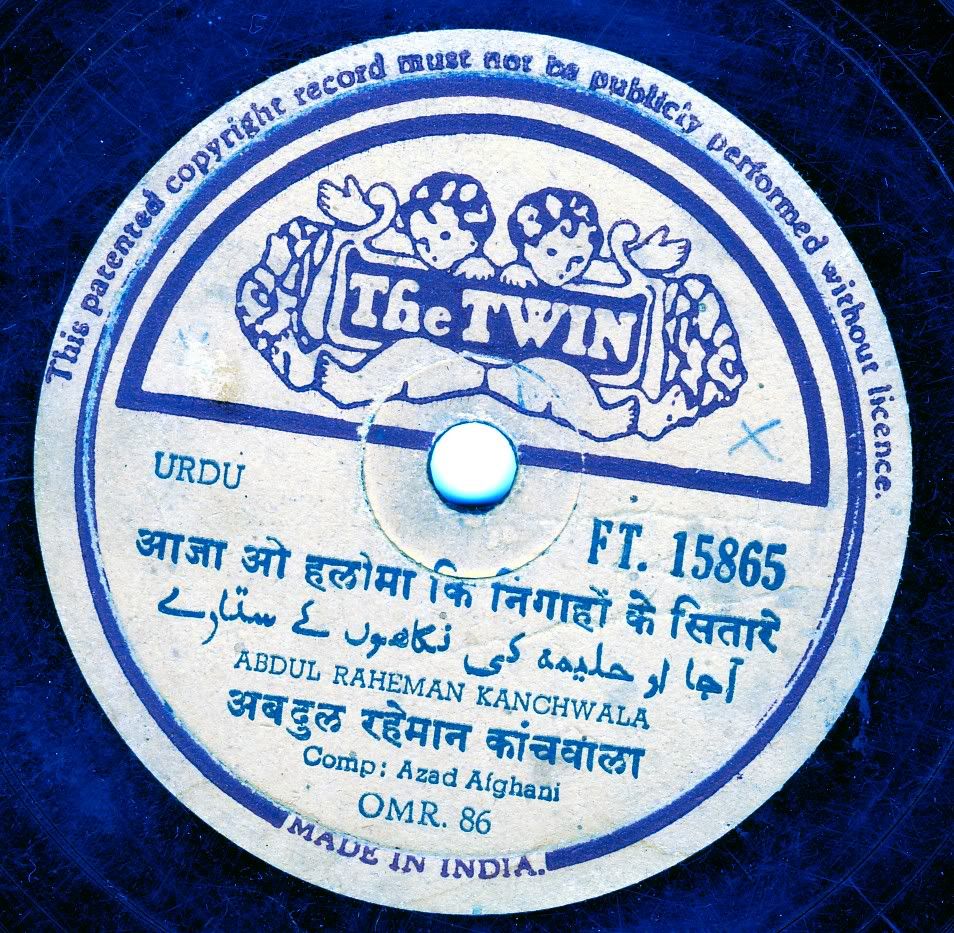
Abdul Raheman Kanchwala: Jawoonga Khwaaja dard-e-dil sunane ke
Abdul Raheman Kanchwala: Aa jaa o halima ki nigahen ke sitare

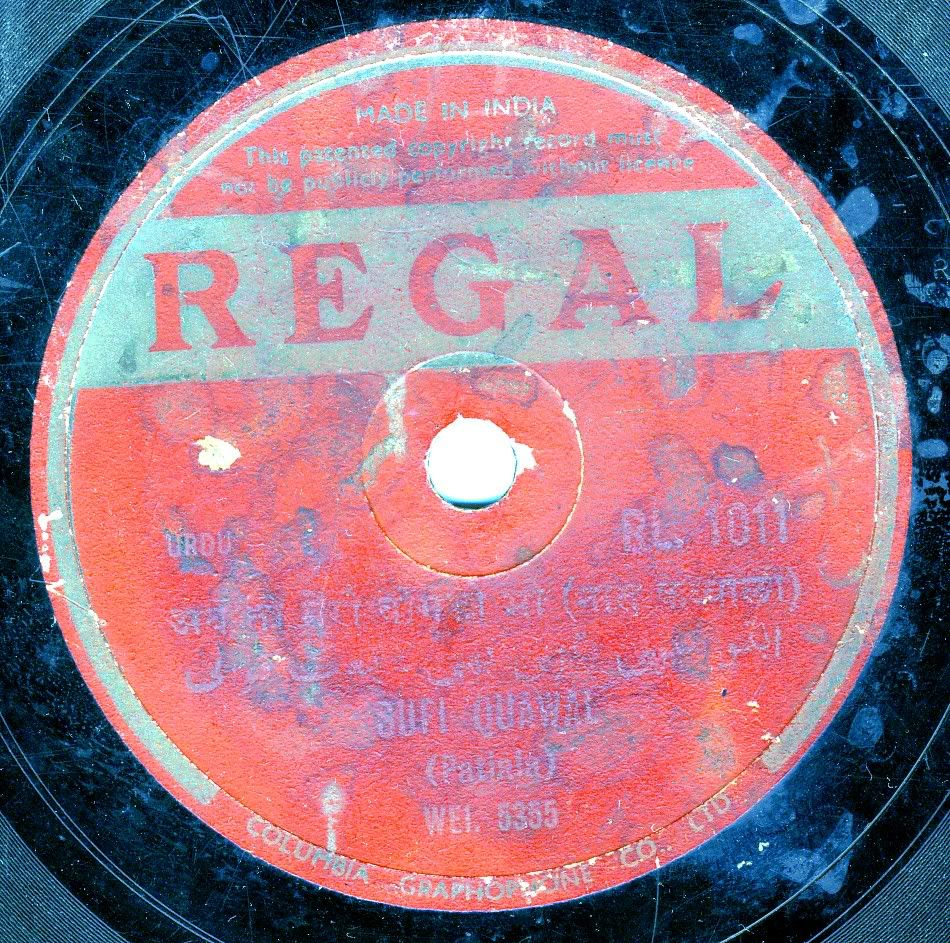
Sufi Quawal (of Patiala): Aa mota dilaka khatkaa
Sufi Quawal (of Patiala): Ab to mera bimahi bhi
India Indian music music vocalists: 78 rpm discs musical theater
by Warren
leave a comment
Meta
SiteMeter
Brighter Planet
78 rpm Records of Indian Music: “Khaki Putla” — featuring Mianbhai and Mahomed
I can’t offer much beyond inferences about these two sides on the Zonophone label. My guess is that “Khaki Putla” was the name of a drama, and these two songs are part of the complete “soundtrack.” Mahomed, the singer on “Tap karna aaya,” has very nice technique.


Mianbhai: Aay maula arabhi
Mahomed: Tap karna aaya
India Indian music music vocalists: genius
by Warren
leave a comment
Meta
SiteMeter
Brighter Planet
Jawab Nahin.
Raga Kafi: Piya to manata nahin. This looks and sounds like a mid-70s recording.
India Indian music music vocalists: 78 rpm discs musical theater Parsi
by Warren
2 comments
Meta
SiteMeter
Brighter Planet
78 rpm Records of Indian Music: Sorabji Katrak of the New Alfred Company
These songs are part of the early 20th century culture of musical theater in Bombay. The New Alfred Theatre Company was founded in the late 19th century by Kawasji Palanji Khatau to present plays in Gujarati, Marathi and Hindi.
Kavasji belonged to a poor family and lived in the Sankary lane near ‘Dukkar Bazzar’ (pig market) around ‘Dhobi Talao’ area [a place very close to Metro cinema]. Amrut Keshav Nayak was the director of the plays staged. He staged several plays including Murad, Allauddin, Gorakh Dhanda, Mahabharat, Asir-e-hirs, Abhimanu, Chandraval, Harishchandra etc. Alfred company had many owners in 60 years: Nanabhai Rustomji Rana, Mohammad Ibrahim, Manekji Master. Later on Mr. Khatau once again owned it and renamed it as ‘New Alfred Theater Company’. The company was operational until about 1932 with last ownership of Jahangir, son of Mr. Khatau. Along with the Alfred Company, some amateur and professional companies also staged Urdu and Parsi plays and toured to Calcutta and Rangoon in Burma.
Around 1905, many record companies approached these companies and cut discs of songs and dialogues. Beka records, Sun Disc, Gramophone Company, Ramagraph, James Opera cut over 300 songs of renowned artists: Master Mohan, Master Bhagoo, Dayashankar Vasanji, Sorabji Katrak, Ibrahim, Bhurekhan, Meer Himmat Kalu alias Master Himmat, Murad Ali, Phiroz Shah Misrty and many others.
Sorabji Katrak was one of the popular male vocalists from the Alfred Company.
Gujrathi theater was full of actors from Saurashtra, North Gujrath and Mumbai. {snip} Among Parsi’s were: Sorabji Katrak, Sorabji Kerawala, Sorabji Dhondi and Ferdoon Irani.
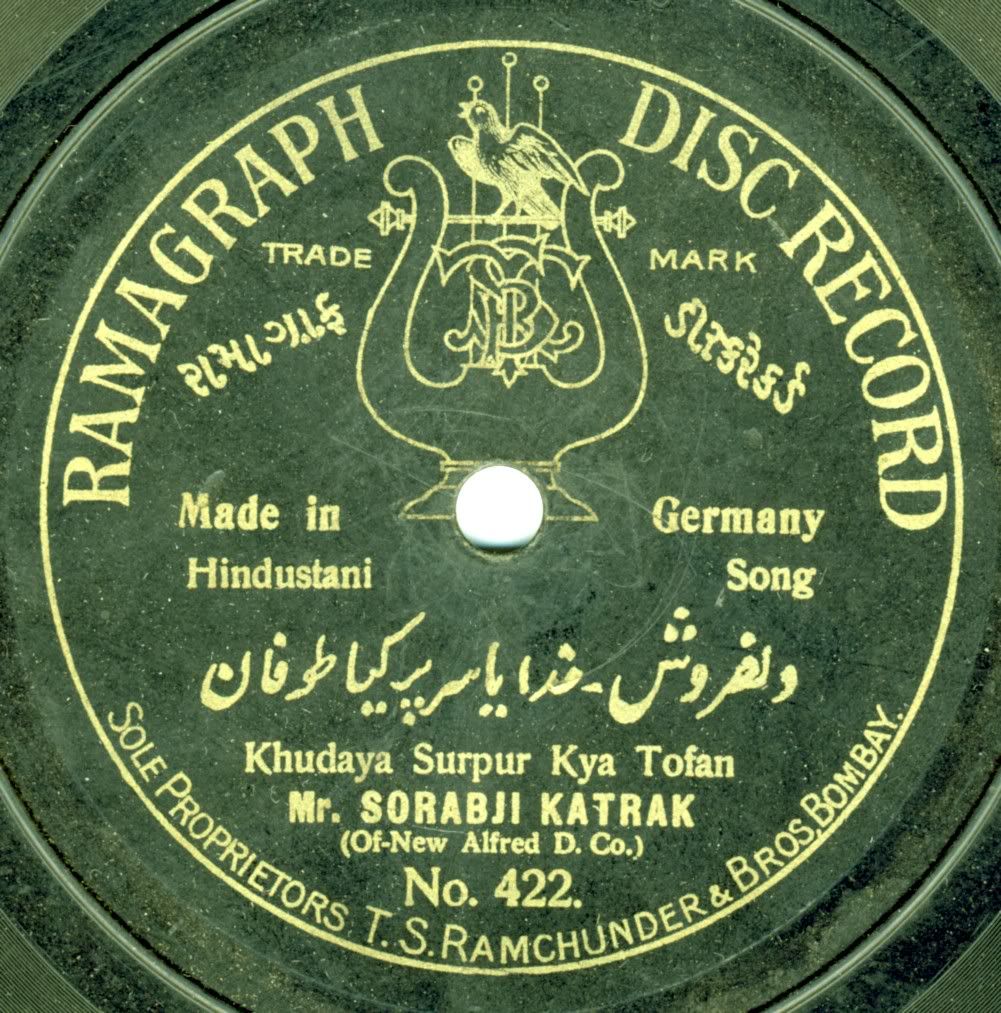

I am assuming these lyrics are Gujarati — perhaps someone can figure out more?
India Indian music music vocalists
by Warren
3 comments
Meta
SiteMeter
Brighter Planet
78 rpm Records of Indian Music: Pandit Shikarpuri
No information seems to be available about Pandit Shikarpuri. Perhaps, as his name suggests, he’s originally from Shikarpur.

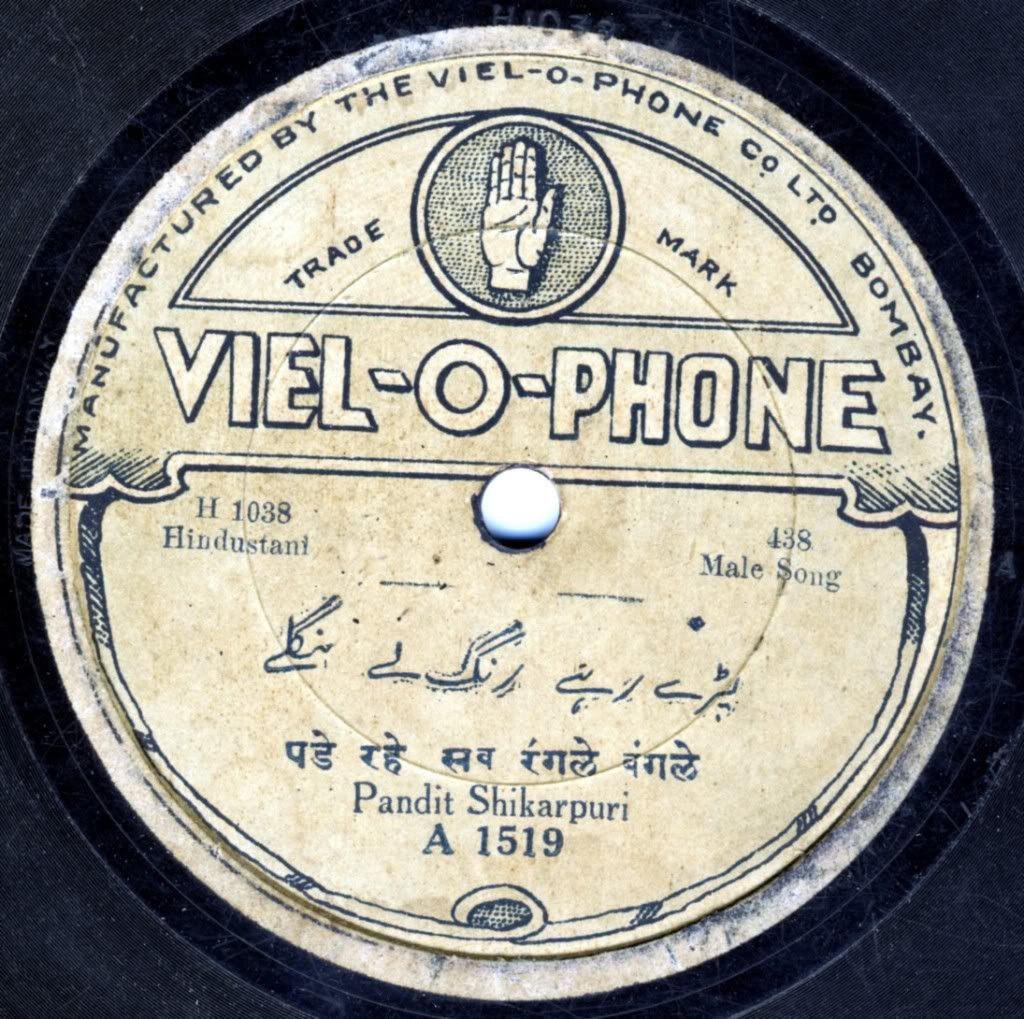
Homeopathic doses of information are available about the record label:
Michael Kinnear says this about Viel-o-phone:
…Valabhdas Runchordas established his own record pressing factory in 1914 under the name of the Viel-o-phone Co., Ltd., in Bombay.
On the other hand:
During 1926, Valabhdas Runchordas, who had been in the sound recording industry in Bombay since 1902, and a persistent rival of The Gramophone Co., Ltd., organised a company in the name of The Viel-o-phone Co., Ltd., with a disc record factory at Matunga, in the northern suburbs of Bombay with the co-operation of Edison Bell, Limited, London .
By mid-1927, The Viel-o-phone Co., Ltd., was producing and pressing disc records under a variety of labels, however, technical and financial problems had forced the closure of the Matunga factory by early 1933. The pressing of disc records by the Matunga factory had encouraged The Gramophone Co., Ltd., to organise a subsidiary company in the name of The Twin Record Co.,. Ltd., Calcutta, in competition with the Matunga factory, often replicating the same releases with releases on the ‘Twin’ label under pseudonyms.
These songs have distinct classical flavorings, but don’t showcase any fancy improvisation. Shikarpuri’s voice is clear and well-modulated; I quite enjoy this pair of geets.
A confession: my purchase of many of these records was purely impulsive — after going through huge stack after huge stack of grimy HMV discs, I would get heartily sick of looking at Nipper looking into the Victrola, so any labels that presented a contrast automatically went into my “to-buy” stack.
India Indian music music: 78 rpm discs East-West fusion fusion music
by Warren
3 comments
Meta
SiteMeter
Brighter Planet
78 rpm Records of Indian Music: K.C. Mookerjee and G.C. Chatterjee
Here’s an interesting oddity, an early piece of East-West fusion music. Mukherjee and Chatterjee are playing piano and violin, accompanied by tabla. The music is only accidentally Hindustani, although the tabla player, faute de mieux, is pounding out tintaal. The pianist’s approach sounds informed by Western music, while the violinist uses Indian-style slides. The repertoire is gat-derived, with “asthai” and “antara” sections, but any raag contours are obscured, and if there’s improvisation I’m not hearing it. The slight acceleration is typical of Hindustani style.

The same recording is featured on both sides of the disc.
humor India Indian music Jazz music: 78 rpm discs early jazz novelty music
by Warren
3 comments
Meta
SiteMeter
Brighter Planet
78 rpm Records of Indian Music: The Manhattan Jazz Band
Here’s a change of pace: a disc from the “Manhattan Jazz Band,” released on the Calcutta-based Zonophone label. My best guess is this was from some point in the 1920s or 30s; the music is what was called jazz at the time — by people who didn’t know what jazz was.
In the late 1990s I picked up a great many 78s at a small store in Bombay’s Chor Bazaar. Among them were a few of these recordings of “English Music.” Apparently these were mostly recorded in England and released in India, for the enjoyment of the Brits. I had a brief fantasy that these were Indian musicians hired to play this repertoire, which would have been ethnomusicologically fascinating. Turns out that’s not what happened. Ah, well.
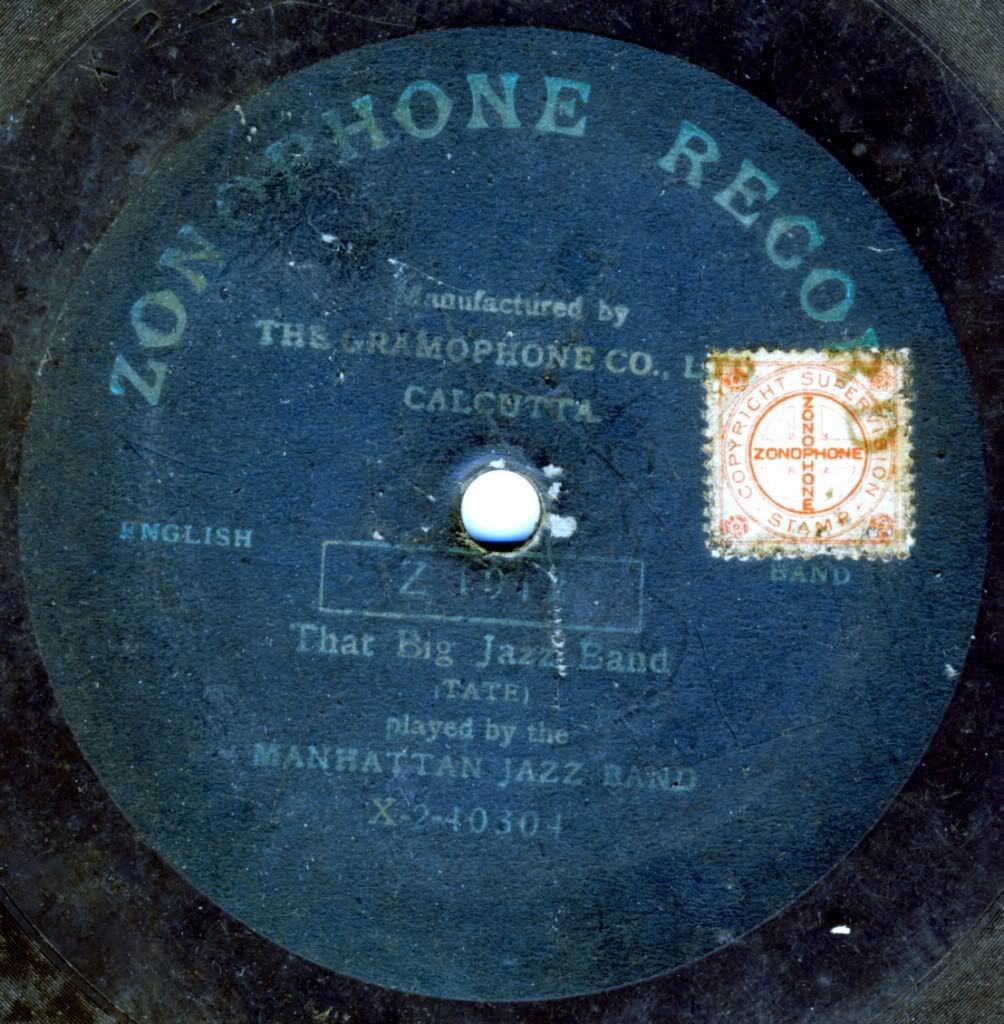
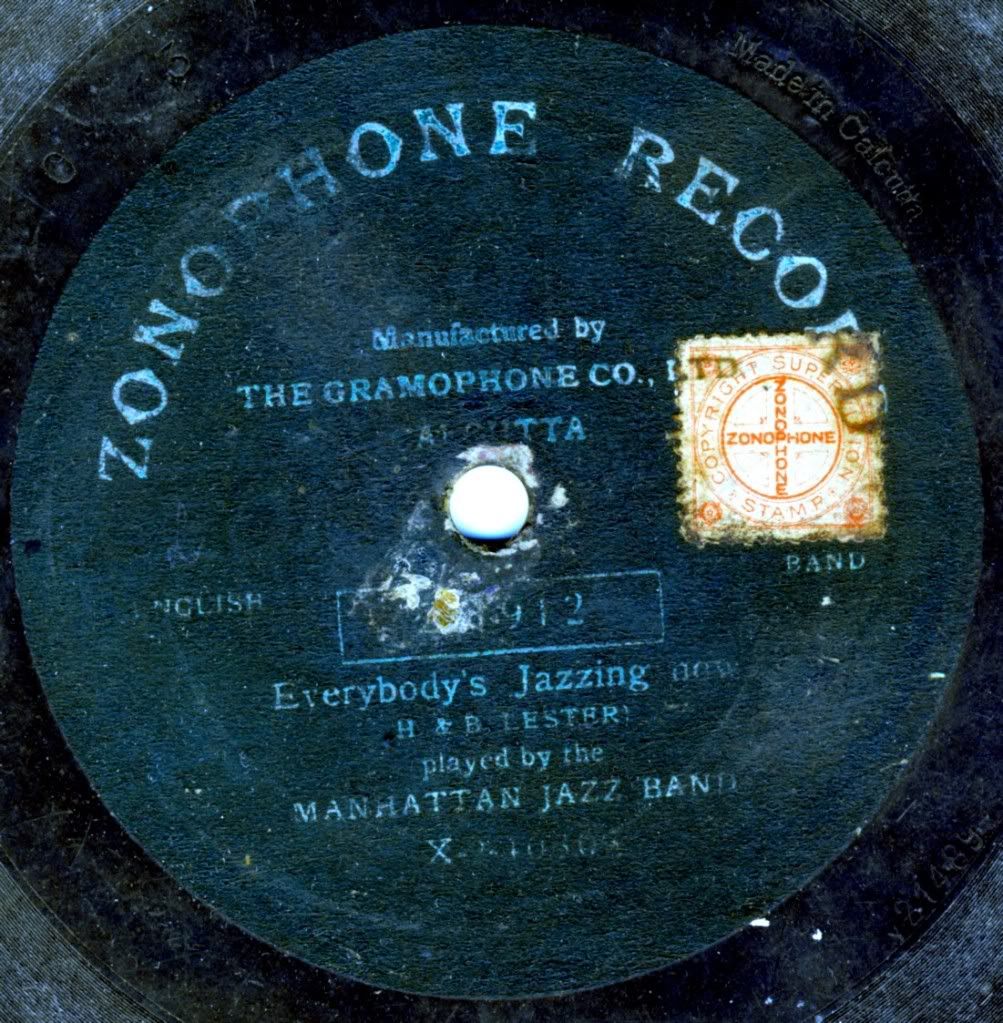
The amount of crud on the surface of the disc is beyond imagination.
Enjoy “Everybody’s Jazzing Now”:
And here’s “That Big Jazz Band”:
